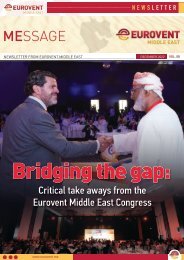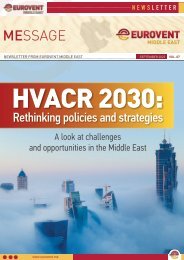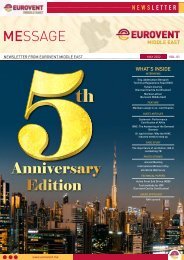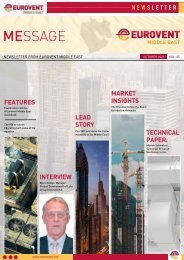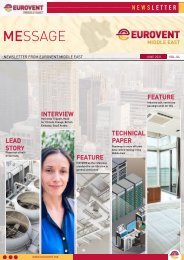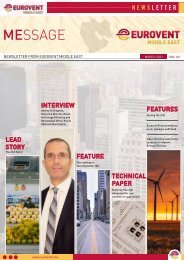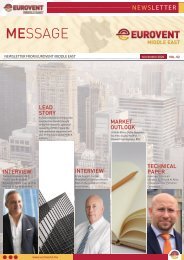EME Newsletter MEssage #01/2023
HVACR Industry news from Eurovent Middle East
HVACR Industry news from Eurovent Middle East
Create successful ePaper yourself
Turn your PDF publications into a flip-book with our unique Google optimized e-Paper software.
NEWSLETTER<br />
INSIGHTS<br />
Regulatory developments in the GCC<br />
Regulatory bodies in the region are back in full steam to revise existing regulations for air<br />
conditioners after two more quiet years owed to the pandemic. Markus Lattner, Managing<br />
Director of Eurovent Middle East, shares insights into discussions, developments and the<br />
association’s positions.<br />
Currently, regulations for both small<br />
and large-capacity air conditioners<br />
(GSO 2630, SASO 2663, SASO 2874,<br />
UAE.S 5010-1, UAE.S 5010-5) are<br />
under revision by the respective<br />
bodies and technical committees,<br />
which are working in full steam. To<br />
fully understand the implications<br />
of regulatory developments, it is<br />
important to dissect a technical<br />
regulation into its major parts.<br />
Normative References<br />
For one, normative references<br />
ultimately determine under which<br />
standards and test methods a<br />
product is allowed to enter a<br />
market. The references commonly<br />
used internationally in the HVAC<br />
sector are ISO, EN and ANSI<br />
standards. The decision of which<br />
one specifically to apply is a<br />
challenging one. In this globalised<br />
time, products and components<br />
are manufactured and shipped<br />
around the world. For instance,<br />
most air conditioning equipment for<br />
IT cooling sold in the Middle East<br />
is produced by European factories.<br />
However, that doesn’t mean they<br />
are European companies.<br />
Most of the big international players<br />
from Asia, Europe and America have<br />
production lines all over the globe<br />
and produce for local and regional<br />
markets, but also beyond. The<br />
industry is not divided along political<br />
borders but rather bound to what<br />
the markets demand. Inclusivity<br />
in terms of normative references<br />
thus is preferred by manufacturers<br />
to allow flexibility in regards to<br />
their supply chain. As long as the<br />
standards referenced reflect the<br />
latest versions and are comparable<br />
in terms of testing methodology and<br />
results, it provides much-needed<br />
fairness in market access.<br />
For some products, ISO standards<br />
have been agreed to by most<br />
of the players and became the<br />
preferred option, while for other<br />
products EN or ANSI standards still<br />
prevail, mostly due to weaker or<br />
lacking ISO coverage. Additionally,<br />
environmental conditions<br />
demand regional adjustments of<br />
international standards to reflect<br />
the increased requirements for<br />
energy performance and durabilites<br />
in the region.<br />
Normative references also have<br />
significant impact on market<br />
surveillance and regulatory<br />
Markus Lattner<br />
compliance. In itself a crucial<br />
point for a closer look, which I<br />
will get back to in a bit. Overall,<br />
it is important to address such<br />
references on a product-by-product<br />
basis, to clearly understand the<br />
origins of equipment and avoid<br />
interruptions of supply chains.<br />
Minimum energy performance<br />
requirements<br />
Minimum energy performance<br />
requirements (MEPS) are core and<br />
purpose of such regulations. They<br />
define minimum efficiency values<br />
for products in the market and are<br />
the basis of any energy labelling. In<br />
the current revisions, authorities<br />
are set to change from EER to SEER<br />
(Seasonal Efficiency) calculations.<br />
The industry fully supports this<br />
transition as SEER provides a more<br />
realistic calculation of energy<br />
consumption, especially with more<br />
variable speed technology in place.<br />
As SEER is based on weather<br />
bins, it can be fully adjusted to<br />
local requirements. Eurovent has<br />
looked at various weather bins in<br />
the region and concluded, from<br />
sample calculations, that the<br />
differences among weather bins<br />
of Saudi Arabia, Kuwait and UAE<br />
lead to only marginally different<br />
SEER values, opening the door<br />
for a regional unified weather bin<br />
and harmonisation of regulations<br />
across the GCC, even for Kuwait.<br />
In terms of defining minimum<br />
requirements, the discussion is<br />
ongoing. While split units have<br />
taken a leap with the inverter<br />
technology, the region still<br />
holds on to window-type ACs,<br />
widening the possible range of<br />
energy efficiency labels. Here the<br />
question stands if an energy label<br />
which starts at a SEER value of<br />
8 and rises in steps up to above<br />
19 is really effective. After all, it<br />
would do little to push the market<br />
to better performances.<br />
As an industry association, we<br />
believe a bolder push to raise<br />
efficiency levels is possible.<br />
Not taking any side for or<br />
against technology, but some<br />
manufacturers have shown<br />
that also window types can be<br />
fitted with inverters, improving<br />
their efficiency significantly over<br />
non-inverters. The technology<br />
is freely available and would<br />
allow also local producers to<br />
adjust. Increasing the minimum<br />
requirements would therefore be<br />
feasible. But this, ultimately, is a<br />
decision the government has to<br />
take.<br />
Compliance<br />
Compliance requirements make the<br />
third major part of a regulation and<br />
the part which can inflict the highest<br />
costs on suppliers. The Middle<br />
East depends a lot on pre-market<br />
testing of imported products. This<br />
means that before a unit is shipped,<br />
manufacturers must apply, register<br />
and get their products approved by<br />
the authorities, or else shipments<br />
would be denied entry into the<br />
country. This adds substantial<br />
administrative, testing, and<br />
certification costs.<br />
In a price-sensitive and highly<br />
competitive environment, one can<br />
imagine that the interpretation<br />
and execution of regulatory<br />
requirements can make a huge<br />
difference. The industry needs a<br />
fair and level playing market. Every<br />
manufacturer wants to ensure<br />
that his competitor follows the<br />
same rules. Thus, ensuring that all<br />
products are fully in line with the<br />
laws and regulations is absolutely<br />
critical.<br />
Owing to the lack of local testing<br />
capabilities, market surveillance<br />
is not a strong point in the region.<br />
Furthermore, it only really works<br />
for consumer goods, not custommade,<br />
larger equipment. This<br />
aspect underlines the advantage of<br />
independent third party certification<br />
as offered by organisations<br />
like AHRI and Eurovent. Both<br />
have established certification<br />
programmes in cooperation with the<br />
industry, allowing an independent,<br />
objective and neutral certification<br />
of product performances, which a<br />
majority of manufacturers already<br />
use.<br />
These certifications are requested<br />
by planners and consultants<br />
and are, therefore, already in<br />
wide use. And such certificates<br />
are also in place for customised<br />
equipment, which otherwise<br />
wouldn’t be possible to assess<br />
if not for a unit by unit testing,<br />
for which neither enough testing<br />
capacities exist, nor would it<br />
make any financial sense. So, why<br />
are we not using these already<br />
existing certifications to prove<br />
compliance with regulations?<br />
Eurovent for instance, has already<br />
adapted its certification to Middle<br />
East requirements, reflecting<br />
the need for T3 conditions in<br />
testing methods. It would allow<br />
governments to bring up to 80%<br />
of the market under regular<br />
surveillance, as both AHRI and<br />
Eurovent are based on recurrent<br />
testing, and allows that limited<br />
budgets for market surveillance<br />
can be used to focus on noncertified<br />
products.<br />
It also would relieve<br />
manufacturers from the<br />
requirement of having their<br />
products tested again and<br />
again, with no added benefits.<br />
All it would need is a directive<br />
to notifying bodies that such<br />
certificates are recognised as<br />
www.eurovent.me SEPTEMBER JUNE <strong>2023</strong> 2022 VOL. 01 09





